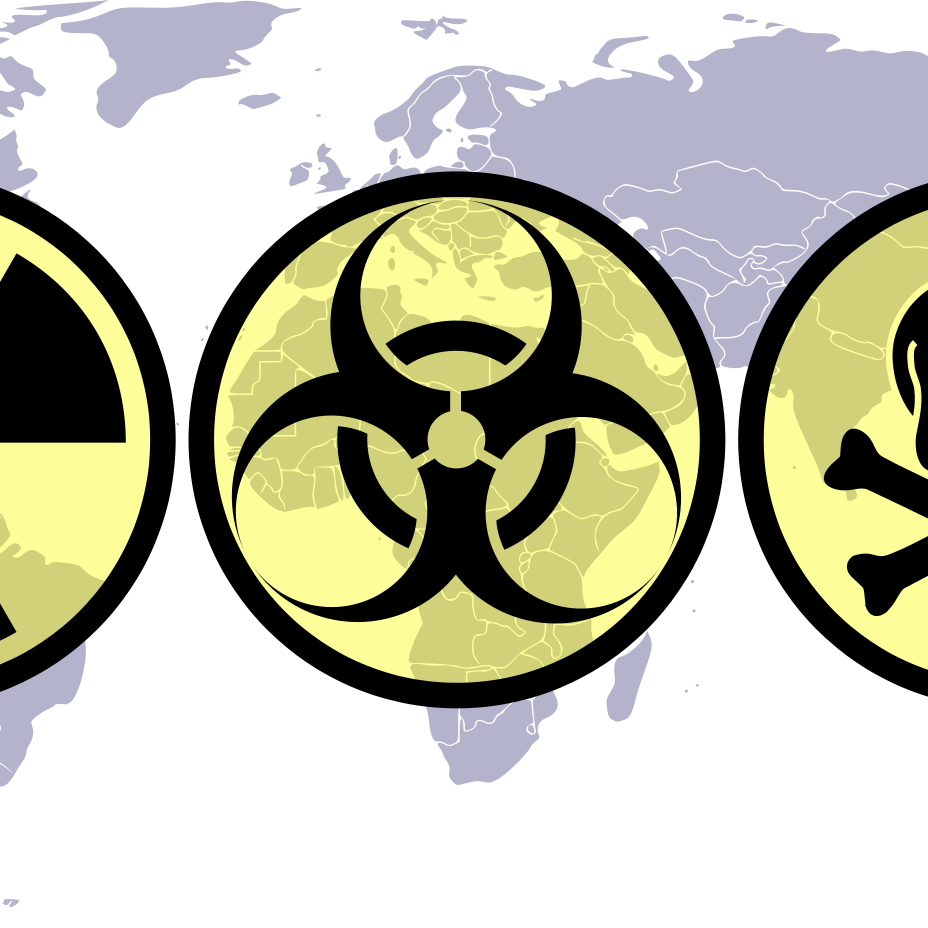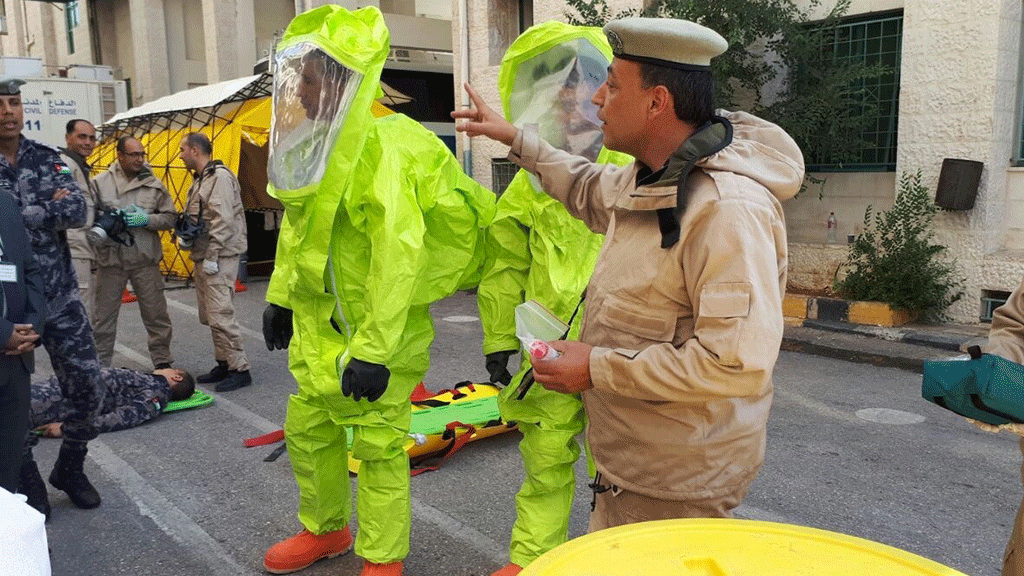Beyond Nuclear: The Other Proliferation Threats

Nonproliferation (n.): limitation of the production or spread of something
Upon hearing the term “nonproliferation,” most people assume the topic of conversation concerns nuclear weapons. The majority of results from your favorite search engine center on the nuclear threat. This is not entirely surprising judging by the many years of negotiations and treaties concerning nuclear material, including the current nuclear talks with Iran. The reality is that nonproliferation is a concept expanding well beyond this limited nuclear view to encompass chemical and biological weapons of mass destruction as well.
This mouthful of a word – nonproliferation – began cropping up in political talks in the mid-20th century, but the concept has been around for much longer: prevent something undesirable from being created, being spread, or being used. As nuclear science rapidly advanced after World War II and the Cold War began, major world powers wanted to limit the spread of nuclear arms. Many bilateral and multilateral treaties have been drafted over the years, including:
1968 Treaty on the Non-Proliferation of Nuclear Weapons
1991 U.S.-Soviet Strategic Arms Reduction Treaty (START I) and 2010 New START
1996 Comprehensive Nuclear-Test-Ban Treaty
Going Beyond Nuclear
The overarching goals of such treaties and talks are to limit the spread of nuclear arms, but in many cases these efforts, despite being necessary to create a safer world, have overshadowed many efforts to prevent the spread of biological and chemical weapons. In some respects, this is surprising.
First, chemical and biological weapons have existed much longer and have been used much more frequently than nuclear weapons. In the case of biological warfare, armies have utilized disease as a weapon throughout history. The first documented account took place during the siege of Caffa in which the Mongols the sent plague-infected bodies of their soldiers into the city. The migration of residents fleeing infection is credited with accelerating the second breakout of the Black Plague. As for chemical weapons, their first large-scale use was in 1915 during World War I in Leper, Belgium. The expenditure of nearly 125,000 tons of chemical weapons during this war caused 90,000 deaths and one million casualties, not to mention the countless lives lost to such weapons in modern conflicts in Iraq, Syria, and elsewhere.
Second, while the nuclear threat is real, the science and technology involved in creating a nuclear weapon is extensive, expensive, and tedious. The creation of chemical and biological weapons is much more accessible. By doing more with less, weapons technicians can mass produce chemical and biological agents much more cheaply and efficiently than nuclear weapons.
Over the past 100 years, many treaties and agreements have been drafted, signed, and ratified to address the proliferation of weapons of mass destruction. Major multilateral treaties have supported and expanded ideas from the 1925 Geneva Protocol prohibiting the use of biological and chemical weapons such as the 1975 Biological and Toxin Weapons Convention and the 1992 Chemical Weapons Convention.
What Are We Doing About It?
The spirit of nonproliferation of these treaties is also found in the mission of the Cooperative Threat Reduction (CTR) Program. United States Senators Sam Nunn and Richard Lugar first proposed the program to Congress in 1992 after the disintegration of the Soviet Union and subsequent concerns about safety and security of Soviet weapons of mass destruction. Understanding the threat that both biological and chemical weapons posed in conjunction with nuclear weapons, three goals were developed for the initiative that would later become the formal CTR program:
Destroy nuclear weapons, chemical weapons, and other weapons as well as their launchers and related facilities;
Transport, store, disable, and safeguard weapons in connection with their destruction; and
Establish verifiable safeguards against the proliferation of such weapons
The Nunn-Lugar CTR program initially supported chemical, biological, radiological, and nuclear (CBRN) nonproliferation only in the former Soviet Union (FSU). Early critics and supporters alike eventually realized that threat reduction and nonproliferation assistance the United States provided to the FSU not only helped Russia to protect its weapons, materials, and knowledge, but also would make it more difficult for terrorists or hostile nation states to acquire CBRN (chemical, biological, radiological, and/or nuclear) weapons of mass destruction. Congress approved expansion of US threat reduction and nonproliferation programs to non-FSU states beginning in 2004, though support for global expansion existed for many years prior. The CTR program has continued to expand and build nonproliferation capacities in a diverse set of countries including those in Africa, the Middle East, South Asia, and Southeast Asia.
Other initiatives aimed at stopping the proliferation of weapons of mass destruction include the US Department of State’s global threat reduction program, which has three main components: the Biosecurity Engagement Program (BEP), the Chemical Security Program (CSP), and the Partnership for Nuclear Security (PNS). Unique to each of these programs is that they move beyond weapons destruction and utilize capacity building to reach their goals. These capacity-building programs are aimed to strengthen risk management practices, enhance in-country detection and surveillance capabilities, bolster security of facilities, encourage collaborative and peaceful research partnerships, and more to reduce threats posed by terrorist organizations or states searching for weapons material, equipment, or expertise.
But the US isn’t the only entity trying to prevent the spread of these weapons. Across the globe there are many actors working to prevent their spread. The Organization of the Prohibition of Chemical Weapons, which was awarded the Nobel Prize for its efforts in 2013 and the BioWeapons Prevention Project, a global network dedicated to ridding the world of biological weapons, are two notable examples. A major example, however, of international collaboration on nonproliferation – for all weapons of mass destruction – is the G-8 Global Partnership (GP) Against Weapons of Mass Destruction.
The GP began in 2002 with $20 billion pledged by the G8 over ten years; G8 leaders agreed in 2011 to extend the Partnership beyond 2012. Similar to the Nunn-Lugar CTR Program, it initially focused on Russia but has since expanded worldwide. The GP now has 27 member countries and has supported cooperative efforts to destroy chemical weapons, dismantle decommissioned nuclear submarines, dispose of fissile materials, engage former weapons scientists, and enhance biological, nuclear, and chemical security. What Have We Learned?
That nonproliferation is not an idea of limited scope. It moves beyond the destruction of nuclear weapons to all aspects of chemical, biological, radiological, and nuclear nonproliferation. When we speak of “proliferation” we need to remember that there are many more threats presented by weapons of mass destruction than just nuclear ones. We have made great strides in achieving nuclear nonproliferation goals, but we must not forget that for the past 100 years we have also been combating the proliferation of biological and chemical weapons. These are still serious threats to global security and health. Bilateral and multilateral treaties, weapons destruction, facility and material security, personnel reliability, and more all contribute to the overall goal of nonproliferation. By “limiting the production or spread of something,” we are keeping dangerous material out of the hands of dangerous people to ensure all facets of global security.



